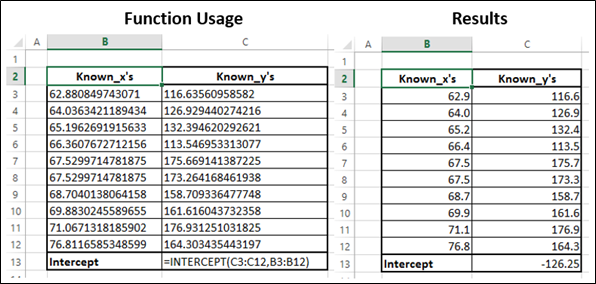
- Advanced Excel Functions Tutorial
- Advanced Excel Functions - Home
- Compatibility Functions
- Advanced Excel Functions - Cube
- Database Functions
- Date & Time Functions
- Engineering Functions
- Financial Functions
- Information Functions
- Advanced Excel Functions - Logical
- Lookup & Reference Functions
- Math & Trignometric Functions
- Statistical Functions
- Useful Resources
- Quick Guide
- Useful Resources
- Discussion
Statistical - INTERCEPT Function
Description
The INTERCEPT function calculates the point at which a line will intersect the y-axis by using existing x-values and y-values. The intercept point is based on a best-fit regression line plotted through the known x-values and known y-values.
Use the INTERCEPT function when you want to determine the value of the dependent variable when the independent variable is 0 (zero).
Syntax
INTERCEPT (known_y's, known_x's)
Arguments
| Argument | Description | Required/ Optional |
|---|---|---|
| Known_y's | The dependent set of observations or data. | Required |
| Known_x's | The independent set of observations or data. | Required |
Notes
The equation for the intercept of the regression line, a, is −
$$a=\bar{y}-b\bar{x}$$
The underlying algorithm used in the INTERCEPT and SLOPE functions is different than the underlying algorithm used in the LINEST function. The difference between these algorithms can lead to different results when data is undetermined and collinear.
For example, if the data points of the known_y's argument are 0 and the data points of the known_x's argument are 1, then −
INTERCEPT and SLOPE return a #DIV/0! error. The INTERCEPT and SLOPE algorithm is designed to look for one and only one answer, and in this case there can be more than one answer.
LINEST returns a value of 0. The LINEST algorithm is designed to return reasonable results for collinear data, and in this case at least one answer can be found.
The arguments should be either numbers or names, arrays, or references that contain numbers.
If an array or reference argument contains text, logical values, or empty cells, those values are ignored; however, cells with the value zero are included.
If known_y's and known_x's contain a different number of data points or contain no data points, INTERCEPT returns the #N/A error value.
If the variance of the specified known_x's evaluates to zero, INTERCEPT returns the #DIV/0! error value.
If either of the specified known_x's or known_y's arrays is empty, INTERCEPT returns the #DIV/0! error value.
Where the slope, b, is calculated as −
$$b=\frac{\sum \left ( x-\bar{x} \right )\left ( y-\bar{y} \right )}{\sum \left ( x-\bar{x} \right )^2}$$
Where x and y are the sample means AVERAGE (known_x's) and AVERAGE (known_y's).
Applicability
Excel 2007, Excel 2010, Excel 2013, Excel 2016
Example
